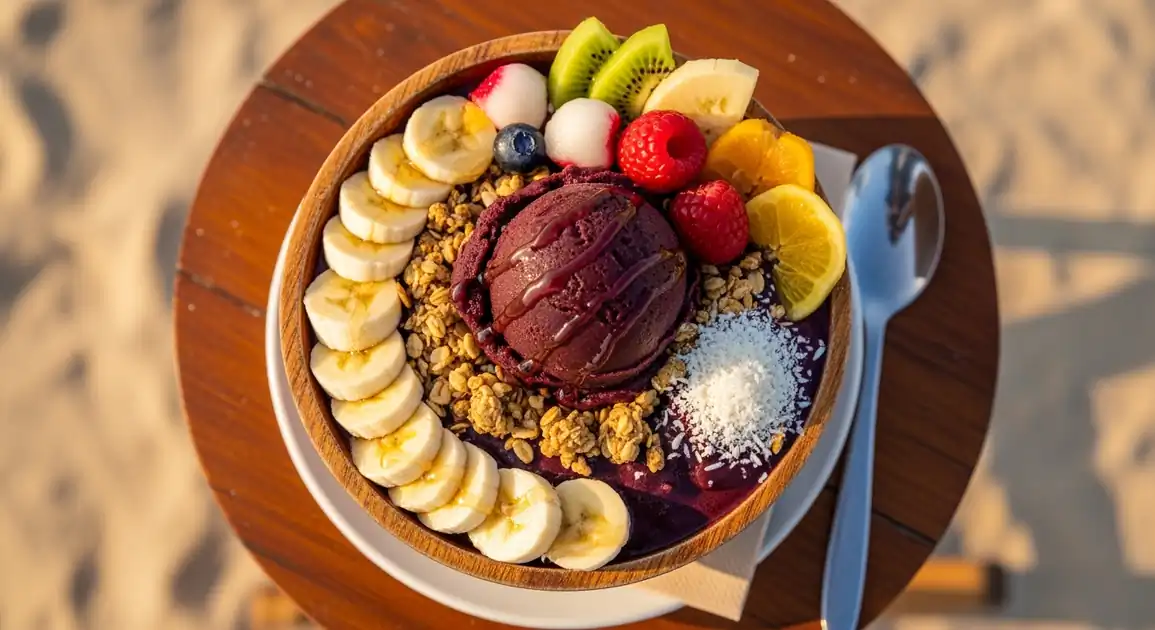Açaí Bowl
Açaí na Tigela

Description
Rio de Janeiro is Brazil's açaí capital outside the Amazon, with the purple treat deeply integrated into the Carioca (Rio local) lifestyle. From upscale Leblon to the crowded Copacabana beach kiosks, açaí is ubiquitous, reflecting the city's focus on beach culture, fitness, and natural foods. In Rio, açaí is primarily enjoyed as a refreshing sweet treat rather than the savory staple it is in northern Brazil.
Dietary Information
Serving information
Serving style
In Rio, açaí is typically served in colorful plastic bowls at beach kiosks, wooden bowls in eco-friendly establishments, or branded reusable bowls at chains. Most places include a spoon and napkin.
Quick facts
Safety Tips
What to Look For
-
Thick, sorbet-like consistency
Quality açaí should be thick enough to eat with a spoon, not drink. Watery açaí may indicate over-dilution with potentially unsafe water or ice.
-
Deep purple color (not artificially bright)
Natural açaí has a deep, almost black-purple hue. Overly bright purple color can indicate artificial additives.
-
Fresh, crisp toppings
Granola should be crunchy, fruit toppings should be freshly cut and vibrant in color.
-
Clean preparation area and utensils
Observe how ingredients are stored and handled. Toppings should be in clean, covered containers.
-
High customer turnover
Busy shops ensure ingredients don't sit out long and are replenished frequently.
What to avoid
-
Pre-made bowls sitting in display cases
Açaí should ideally be prepared to order for optimal freshness and texture.
-
Watery or melting açaí
This indicates poor quality or that it's been sitting out too long, increasing risk of contamination.
-
Uncovered topping stations exposed to air/insects
Toppings should be protected in covered containers, especially in beach areas.
-
Visibly wilted or browning fruit toppings
Indicates old ingredients and poor inventory management.
-
Vendors using the same scoop for different toppings without washing
Can cause cross-contamination issues for those with allergies.
Price information
Price range
Budget tips
- Neighborhood juice bars away from tourist areas typically offer açaí bowls 5-10 BRL cheaper than beachfront vendors.
- A small açaí (pequeno) is often sufficient and costs around 12-18 BRL at most locations.
- Many places offer a 'combo açaí' with a sandwich or tapioca for 25-30 BRL.
- Some vendors give discounts for regular customers or during off-peak hours.
Value indicators
- Consistency should be thick enough to eat with a spoon, not drink with a straw.
- Generous toppings without charging extra for basics like granola and banana.
- Made to order rather than pre-prepared.
- Quality of granola (artisanal vs. commercial).
Where to Find This Dish
Ipanema/Leblon
Higher-end açaí shops with organic options and premium toppings.
Posto 9, Rua Dias Ferreira, Rua Garcia D'Ávila
Afternoon, Post-beach rush (4 PM - 7 PM)
Copacabana
Numerous beach kiosks and juice bars catering to tourists and locals alike.
Copacabana Beach kiosks, Avenida Atlântica, Rua Barata Ribeiro
10 AM - 6 PM, Especially busy weekends
Barra da Tijuca
Popular among athletes and surfers with protein-enriched options.
Pepê Beach, Shopping Barra, Avenida Olegário Maciel
Early morning (post-surf), Late afternoon
Centro/Lapa
Affordable local juice bars frequented by workers and students.
Near Carioca metro, Rua da Carioca, Around Largo da Carioca
Lunch hour (12 PM - 2 PM), After work (5 PM - 7 PM)
Vendor Tips
- Look for places advertising 'açaí natural' or 'açaí puro' for less processed options.
- Chains like 'Toca do Açaí' and 'Amazônia Açaí' maintain consistent quality but local juice bars often have more authentic preparations.
- In Rio, the phrase 'com muito pouco açúcar' (with very little sugar) helps ensure a less sweet bowl.
- Beach kiosks with refrigerated display cases indicating proper storage of açaí and fresh toppings typically offer better quality.
How to Order
Regional Variations
-
Açaí da Praia
(Açaí da Praia)
Beach-style açaí in Rio often features coconut flakes and condensed milk, reflecting the tropical beach culture.
-
Açaí Fit
(Açaí Fit/Fitness)
Popular in Barra da Tijuca and Zona Sul, features protein powder, nuts, and minimal added sugar, catering to Rio's fitness community.
-
Açaí Gourmet
(Açaí Gourmet)
Found in upscale Leblon and Ipanema cafés, featuring premium ingredients like organic granola, artisanal honey, and exotic fruits.
-
Açaí Carioca
(Açaí Carioca)
The quintessential Rio style with guaraná syrup, granola, banana, and often condensed milk or honey, found throughout the city.
Cultural context
History
Açaí has been a staple food of indigenous Amazonian tribes for centuries. Originally consumed as a energy-boosting food by riverine populations in northern Brazil, açaí na tigela as we know it today emerged in the 1980s when the frozen pulp began to be transported to southern Brazil, particularly Rio de Janeiro. Surfers in Rio popularized açaí bowls as the perfect post-surf refreshment, valuing its energizing properties. From beachside consumption, it evolved into a national phenomenon and eventually gained international recognition as a superfood in the early 2000s.
Local significance
In Rio, açaí represents the intersection of beach culture, fitness lifestyle, and natural foods that define the Carioca identity. It's both everyday sustenance and a cultural symbol.
Eating customs
- Cariocas often judge açaí quality harshly – thickness and proper temperature are essential.
- Many locals mix the entire bowl thoroughly before eating.
- In Rio, açaí is rarely consumed without granola – the textural contrast is considered essential.